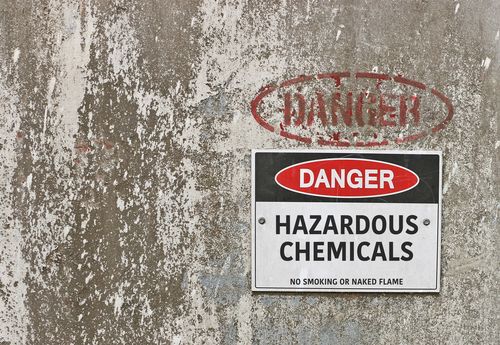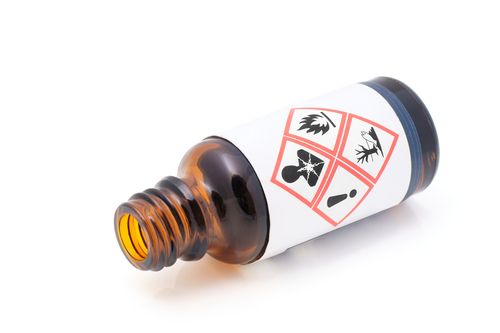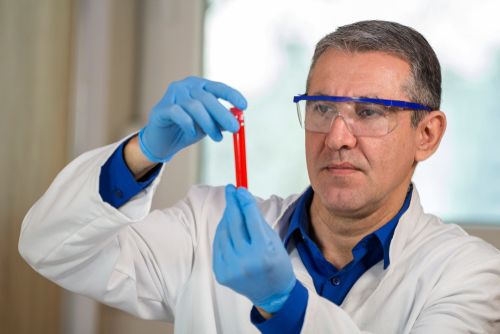Chemical burns can occur at home, work, school, and almost any place you go. Burns from everyday products you handle regularly can have a serious impact. When you work with strong bases or acids, it’s always a good idea to know what to do when a chemical burn happens to you. Your ability to act quickly could keep the degree of the burn to a minimum.
Chemical Burn Treatment
Step 1: Always Use Protective Gear
Prevention is always the best approach to chemical burns. Start by using the right safety gear to create a barrier between the chemical and your skin. Wear the appropriate gloves, lab coat, apron, or other safety gear to keep chemicals from coming into contact with your skin.
Safety glasses are also an essential weapon against chemical burns. Regular glasses and sunglasses don’t offer adequate protection or coverage. Also, keep your feet and legs covered. Shorts and sandals are not appropriate gear for working with any kind of dangerous chemical.
Step 2: Rinse with Clear, Cool Water
Use clear, cool water to flood the area for a minimum of twenty minutes. Make sure the flow of water goes away from you or anyone else, and preferably down a drain. Use enough water to cover the area effectively without using a strong stream.
Some chemicals react with water and shouldn’t be flushed after contact. These include dry lime, elemental metals and phenols. You should brush dry lime off your skin before flushing with water while you need to remove elemental metals and metal compounds like lithium, potassium, and titanium tetrachloride with dry forceps and place them in non-water solutions such as mineral oil.
Step 3: Remove Exposed Clothing and Jewelry
While still flushing with water, remove clothing and/or jewelry that has the chemical on them. If the chemical causes these items to stick to your body, leave them in place.
Step 4: Follow the Instructions on the Chemical Label
OSHA requires any work setting where chemicals are present to have OSHA labels that list first aid instructions. Once you flush the burn, look for the instructions on the label, if available. These instructions pertain to the specific chemical and may differ from that of other chemicals.
Never try to neutralize the burn using an acid or alkali. You could cause a chemical reaction that results in more severe burns. Don’t apply antibiotic ointment, first aid cream, or any other ointment to the burn unless directed to do so by a healthcare provider.
Step 5: Wrap Small Areas
Loosely wrap small burn areas. If the burn area is larger than 3 inches wide or long, go to the hospital immediately. Seek emergency care if the burn is on your hands, feet, face, buttocks, groin, or over a major joint. If the burn is so severe that it causes symptoms of shock such as shallow breathing, low blood pressure, and/or dizziness, you should also go to the hospital.
Step 5: Follow Your Healthcare Provider’s Treatment Instructions
Chemical burns vary a great deal in severity. Treatment ranges from over-the-counter pain medications and anti-itch creams to the use of IV fluids, cosmetic surgery, skin grafts, and counseling & occupational therapy. The treatments your doctor provides will help prevent your burns from developing complications and speed up the healing process.
Minor burns usually heal fairly quickly if you follow the instructions given. People with major chemical burns often have complications including permanent disfigurement, scarring, infection, and depression. Deep burns that affect the tissue and organs below the surface can result in limb loss or permanent muscle and tissue damage.
What Is a Chemical Burn?
A chemical burn is the irritation and destruction of tissue resulting from exposure to a chemical, either directly or from the fumes it produces. Strong acids or bases are most likely to cause damage when they come into contact with the skin. The best way to avoid chemical burns at home is to familiarize yourself with the products you use and follow the instructions carefully.
Most people think that only the chemicals in a laboratory or work environment pose a risk to their well-being. While many of your typical home cleaning, maintenance and personal products are not strong enough to cause severe burns, they sometimes cause irritation or burns to the skin, particularly with misuse or overexposure. Common chemical sources at home include products to dye hair or whiten teeth, rust removers, salt used to clean snow and ice, household cleaners, and drain clog removal products.
Death resulting from chemical exposure in the home is rare but it does happen. It is much more of a risk in laboratory and work settings where strong chemicals are used in large volumes. These chemicals require labeling to reflect their potential risk and to guide you on safe use.
The appropriate treatment for any chemical burn depends on the area where it occurs and the type of chemical involved. Once exposure to the chemical occurs, you need to act quickly to minimize the severity of the burn as much as possible. If you work with strong chemicals daily, become familiar with the properties of each so you know what to do if you or someone else in your work environment spills them.
Chemical Burn Symptoms
You might imagine that spilling a strong acid on your body will result in immediate burning and pain but that isn’t always the case. First-degree burns that only affect the top layer of skin usually cause reddening of the skin and localized pain. First-degree chemical burns often look and feel similar to sunburns.
Second-degree burns are deeper, reaching to the lower layer of skin. These burns often cause more severe pain, blistering of the skin, and swelling. The deepest burns are third-degree which go beyond the lower layer of skin and into the deeper tissue. Third-degree chemical burns often have a charred appearance or whitened or blackened skin that is also numb.
Most chemical burns are first-degree unless you leave them on the skin long enough to go deeper. Because of the various natures of chemicals that cause burns, additional symptoms sometimes occur. These include shortness of breath, severe cough, abdominal pain, muscle twitching or seizures, headache, bluish lips, hives, irregular heartbeat, or cardiac arrest. Any symptom you develop after a chemical burn requires immediate medical evaluation.
Preventing Chemical Burns
Children are much more susceptible to chemical burns than adults, making it imperative to keep them away from dangerous chemicals. At work and at home, always keep chemicals in their original container. At home, keep cleaning supplies, beauty products, and other products containing chemicals in locked cabinets.
At work or school, chemicals should always be kept in the original containers with the OSHA label intact. Always place a label on the new container when pouring a chemical from one container to another. Wear proper safety gear when working with chemicals and keep them stored in the appropriate containers and cabinets as specified by the labels.
Any facility that deals with strong acids and bases or caustic substances should have an eye wash station at intervals, according to OSHA standards. Chemical exposure to any area of the eye or eyelid may result in permanent damage and varying degrees of eyesight loss. Chemical burns that extend deeper into the eye than the cornea often lead to cataracts and glaucoma.
Rinsing the eye is the first course of action just as it is with burns on any other area of the body. When cleaners or other chemicals get into your eye at home, get into the shower immediately and rinse your eye for at least ten minutes. Keep your eye opened as far as possible to rinse out any chemical underneath the eyelid.
The Potential Outcome for Patients with Chemical Burns
Prompt wound irrigation is the most critical step in reducing the extent of a chemical burn. The final outcome for any burn victim depends on the type of chemical, the severity of the burn, the occurrence of any complications, and whether they follow their treatment plan consistently.
People who incur minor chemical burns usually heal quickly and without any significant interruption to their daily routine. Those with more severe burns may have extensive hospital stays, multiple surgeries, and medical treatment for infection and pain. Every person is different and every burn is unique in some way.
If you work with strong chemicals in any aspect of your job, your employer has the responsibility of supplying you with the necessary safety equipment to protect you from chemical burns. You should never dismiss the issue of safety when using strong chemicals. Taking the right precautions will go a long way towards protecting you and preventing you from experiencing the lifelong impact of a severe burn.
Whether chemical burns occur due to negligence in the workplace or due to an intentional act by another person, you have the right to file a personal injury claim to get justice. Contact Ingerman & Horwitz to schedule an evaluation so we can discuss your burn injury case.















